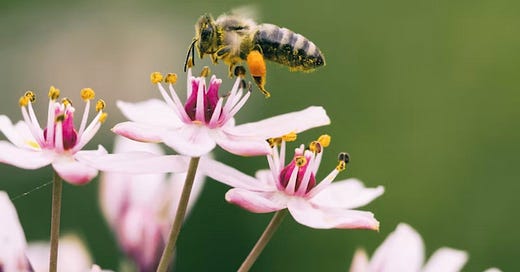Wondering Wednesday Q&A #20
How do bees breathe, how do other organisms breathe, and what can this teach us?
This post will be somewhat about honey bees but also about breathing in general. And it's going to be a little philosophical, brace yourself!
Honeybee anatomy is something I am just getting into, and, as usual, it is fascinating (it’s always fascinating! Anyone else a Mr. Spock fan from Star Trek? That's what he always says: "Fascinating"). I’m not super knowledgeable in this area of science, but a cursory internet search tells me that, in terms of breathing, honeybees are quite typical of the insect world and share my description below with lots of other bugs. Here is a great informational document about breathing in insects that I found.
For starters, bees (and all other insects) don’t have lungs. They have a simpler structure for gas exchange with the air, a tracheal system of branching tubes that get smaller and smaller until the tubes allow oxygen to be delivered to each individual cell. Here is a cool photo from Bee Health Extension. The openings of the tracheal system to the outside air are called spiracles and they are found just under the plates of the bee’s abdomen exoskeleton. Maybe you’ve seen a honeybee sitting still for a moment on a flower (they don't sit still often!) and noticed her abdomen gently expanding as she takes in air through her spiracles, then contracting as she closes them and squeezes air through the tracheal network to every part of her body.
And in addition to having no lungs, bees also have no true blood and no true circulatory system. Again, from the bee health extension: “Bees . . . have an open circulatory system, meaning that they do not have veins or arteries, but rather all their internal organs are bathed in a liquid called ‘hemolymph’ (a mix of blood and lymphatic fluid).” So no lungs, no circulating blood, and yet they breathe (through their abdomens)! Kinda crazy, but much of the insect world is built on a system like this.
Breathing, or perhaps more properly respiration, is an activity that connects all living beings. Nearly all life that we know of needs oxygen for cellular respiration, although there are some interesting exceptions! I did a quick internet search and found this interesting 2020 science news about a parasite that lives in chinook salmon that doesn’t need to breathe. But, it is so symbiotically connected to the salmon that one could argue that the salmon is breathing for it. However, here is another microorganism that is multicellular and respires in deep sea mud with no oxygen at all!
Breathing is a deeply fundamental life activity, and something I’ve been interested in more actively for a couple years now. Looking at honeybees and other insects with no lungs or real circulatory system, and organisms like the ones I mentioned above, one can get a beautiful sense for the activity of breathing. While no structure or substance seems to be absolutely a prerequisite (not even oxygen), the activity of breathing is something that is always present in living beings. There is always a process by which a living organism rhythmically and continuously brings in substances from the outside, incorporates them into itself, and releases other substances from within out to the environment.
Honeybees and all insects represent a stage of complexity that you could imagine as midway between tiny microorganisms and larger animals like amphibians, reptiles, and mammals like us. One begins to realize that, for those of us with lungs and complex circulation, those structures have come about to focus and enhance an activity that was already there before. Following this logic down through to simpler and simpler forms of living things, one can imaginatively erase all the structures and what remains is . . .archetypal breathing. I’ve written about this previously, but it bears repeating. If breathing as an activity precedes all materials, structures and forms, then where can one find breathing in “non-living nature”? I actually think it’s quite easy to find: in the seasons and cycles, the prevailing winds and breezes, the planetary motions, the sun’s cyclical activity, etc. You just have to have the right lens to look through to see that rhythmic movement from inward to outward and back again is a so-called archetypal activity. It connects us all!



Thank you for this fascinating, thought-provoking discussion on the bee breathing and anatomy. You are a wonderful writer, educator, and thinker!